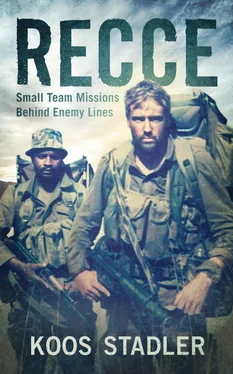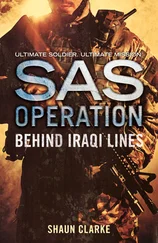One thing that became clear from most sources was that the facilities were locked during the night and that we needed to establish a way of silently breaching the locked doors to the main building.
Looking back today, I realise that the information was sketchy, the aerial photography vastly inadequate and the reports from agents on the ground severely lacking. But we had a job to do and we assumed that we would be able to do a recce of the target before the penetration.
Frans and I went on a lock-picking course to master the trick of gaining access through locked doors. After five days of picking locks, I was ready to work my way into just about any vault in the country. Once we breached the perimeter, it would be my job to get us inside the conference hall, so I spent lots of time picking the locks of every door in Special Forces HQ at night.
After extensive brainstorming sessions between the team and explosives experts from EMLC, an ingenious device was designed. Explosive charges were fitted to the back of six large blocked photos of Nelson Mandela, Govan Mbeki and other high-ranking ANC leaders. The photos, which were obtained through Special Forces Intelligence, were old and grainy, but they looked authentic enough to pass casual scrutiny. The photos were glued on to a moulded frame of sheet explosives with a layer of ball bearings in front, transforming the innocent-looking posters into lethal Claymore mines. A timing device would be fitted in a gap at the back of the explosives.
Our job would be to arm the timers and glue the deadly posters to the inner walls of the conference venue. They would explode the next day when the majority of conference-goers would be in the hall.
Rehearsals were done in and around Pretoria. At Ditholo, a small military air base north of the city, we practised parachuting at low level from the aircraft, a Cessna Caravan II, which had been modified for static-line parachuting as well as to conceal our weapons and equipment. For the parachute drop, the door was refitted for easy removal. A cable was fixed to the inner starboard side for the parachute static lines to be attached to. Initially we considered freefall parachuting, but this was ruled out for a number of reasons, the most important being that we needed to approach the target area at low level to avoid detection by radar. At the time, the three of us were also too inexperienced to guarantee accurate regrouping and landing at night. In the final instance, landing a high-velocity freefall parachute on an unprepared and unmanned DZ at night was too high a risk.
To accommodate the equipment, seats were removed from the centre of the aircraft and a large box fitted – more or less representing a long-range fuel tank. In it would go the HF radios for both the Tac HQ and the team, our weapons and ammunition, and all the explosive charges with their mechanisms. Special bags were also designed so we could parachute with the posters and carry them to the target.
Each of us had to memorise a cover story and received an alias passport to complement the cover. I chose to be an environmental expert from the UK who worked as game ranger in Tanzania’s parks, while Diedies was a wildlife photographer and Frans a tourist. These cover stories would not stand up to close scrutiny, but would at least buy us time in an emergency.
As part of our cover, we decided to wear civilian clothing in shades of khaki and dark grey that would also help with camouflaging during the final stalk. At night, once everyone had left and the Special Forces HQ buildings were empty, we practised our stalking techniques until the small hours of the morning.
Finally, after four weeks of extensive preparation, we departed for Malawi. The pilot flew the Cessna to Blantyre and from there to the Nyika Plateau, while the operators took different commercial flights and met up with an agent from Chief of Staff Intelligence at a hotel in Blantyre. Vehicles had been arranged to transport everyone to the Nyika National Park.
By the time we arrived, Hannes Venter and Dave Scales had already set up our secret little post in a forest. For the game rangers and personnel of the park, we were a bunch of business executives breaking away on an African safari. Our HF radio antenna could be explained by claiming that Dave was a radio ham communicating with our business partners in other parts of the world. We spent a few leisurely days in the reserve making final adjustments to the plan and working through our emergency procedure with Hannes, Dave and the pilot.
Then a cold and misty D-day arrived and we donned our ops kit. The door of the Cessna was removed, seats were taken out, parachutes were prepared and the four passengers boarded – Diedies, Frans, myself and the doctor.
I have never been so hot and so cold at the same time as during that night. The pilot flew at 15 000 ft and the icy wind rushed in through the open door, but I was pressed into the side of the aircraft and lay on top of the heating system which had been turned on full blast for the flight. In front I was freezing, while my backside was being fried, quite literally leaving streaks of burnt flesh on my sides!
About 10 km from the DZ the pilot descended to 3 000 ft above ground level, trying to locate the agent’s strobe. But the DZ was situated within the Morogoro Crater and was surrounded by mountains, which made it extremely dangerous to descend to 800 ft, the height from which we had to exit. After circling the area for twenty minutes, the pilot decided to withdraw.
Bogged down by parachutes and kit at the back of the aircraft, we could not communicate with the pilot and therefore had no idea what was going on. The pilot was unable to establish communications with the agent and he also could not distinguish the strobe from the numerous lights in the valley below. He had explored all alternative RVs and signals, and had concluded that Angel could not make it to the target. The pilot decided not to drop the team onto an unmanned DZ and aborted the mission.
Now another challenge faced us. Back at the Tac HQ, the fog had moved in, covering the whole Nyika Plateau and making it impossible to land. After consulting with Hannes, the pilot decided to divert to Lilongwe, hoping the mist would allow us to land there. Of course, since no flight plan had been filed, there would be questions once we landed. The parachutes were still in the aircraft and the door had been removed. The moment called for quick decisions.
On final approach to Lilongwe International at 02:00 that morning, the pilot informed the tower that we had an emergency on board and needed to land. We landed safely and the pilot taxied far down the runway, allowing the three operators to jump out with all the ops kit and withdraw into the shadows at the end of the airfield. We scaled the perimeter fence and met up with the agent from Chief of Staff Intelligence on a road adjacent to the airport.
The pilot and the doc faced a tough time having to explain the late-night arrival, but fortunately the plane was not searched, probably because there were no staff on duty. The doctor pretended to be seriously ill, fainting and gagging as the pilot assisted him into the airport building, and finally the police rushed him to hospital.
The next day we all met up at a hotel in the city. Dave Scales had driven from the Nyika Plateau to Lilongwe in the early hours of the morning and we were reunited with our luggage. After a quick debrief, we left on different flights to South Africa.
Later it transpired that Angel had indeed been in position on the ground. He had switched on the strobe and could hear the aircraft, but did not succeed in establishing communications with the pilot. The lesson I took from Operation Angel was that cooperation with agents had to be tested and rehearsed in the same level of detail as our own contingencies and that the execution of a mission could never rely on the actions of someone outside our circle of professional operators.
Читать дальше












